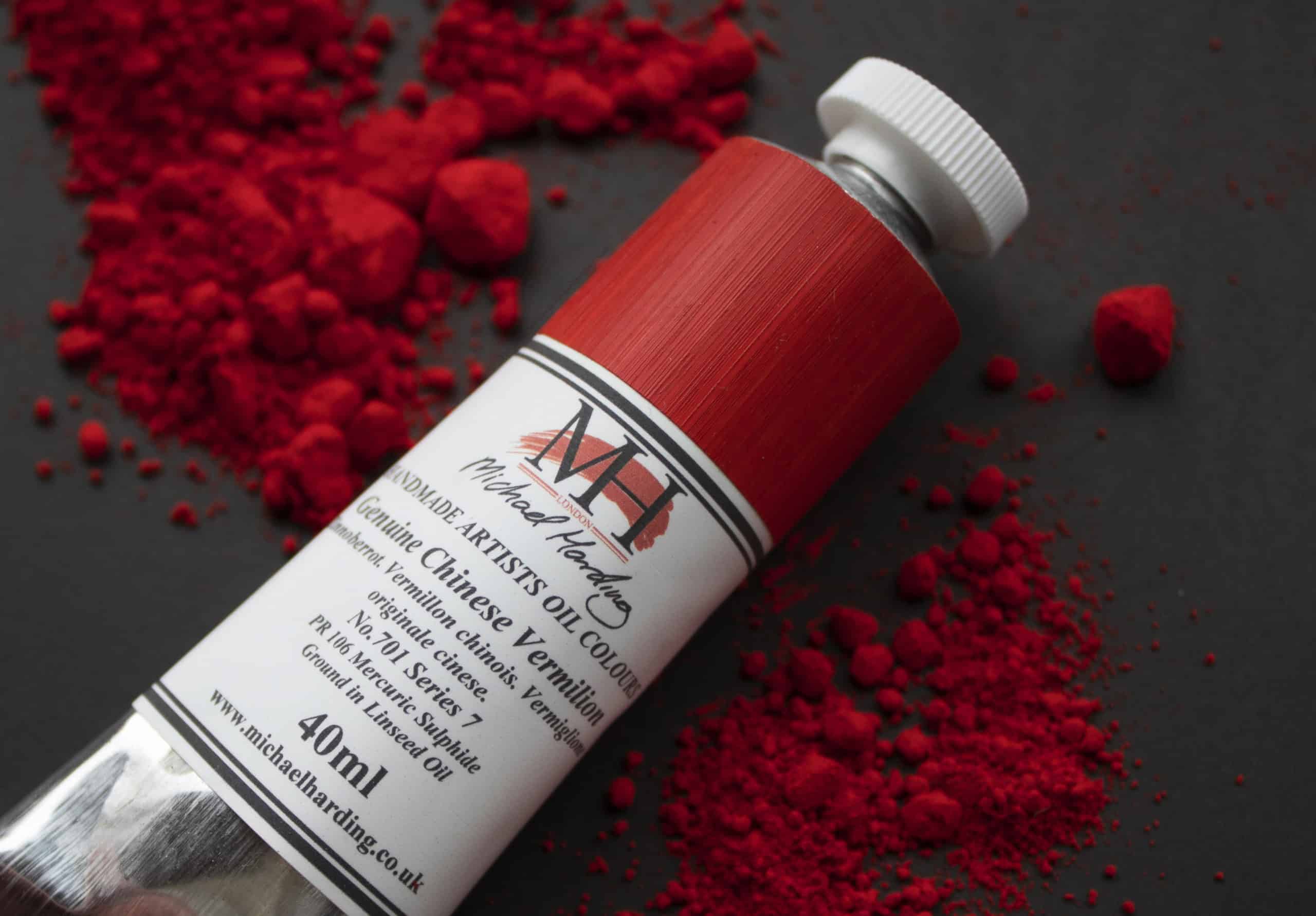The Composition of Paint
If you think of paint as a two-part material, with the oil being the glue that binds the pigment particles into place, it is the pigment that is responsible for delivering the colour. The pigment must therefore have the following qualities:
- It must be light-fast to a reasonable level (i.e., far more light-fast than would be acceptable for house-paint).
- It must not be soluble in oil or in thinners like turpentine.
- It must have the right pH balance (i.e., acid to alkaline) with the linseed oil or other oil into which it is ground; otherwise, the pigment might have little resistance to the bleaching effect of an acidic oil, which would cause a marked colour shift.
- It must not, in normal circumstances, react chemically with other pigments in the range.
So, paint manufacturers choose pigments that possess these properties, or rather the ability to resist these forms of attack. Broadly speaking, we divide pigments into two groups: inorganic and organic.

INORGANIC:
Natural Pigments
These are pigments not made from the tissues or chemical residues of animals or plants. They can be further divided into those that are natural and those that are man-made. The natural are a simple matter to discuss. All our predecessors did was dig them out of the ground or from rock faces. In most instances, these were dry ground with a pestle and mortar until they made a fine powder. In the case of Lapis Lazuli (the original version of Ultramarine Blue), excessive grinding simply causes the blue colour to disappear! Many books tell romantic stories of the mystique that, sometimes inappropriately, surrounds these pigments. For instance, in its natural form, Vermilion was called Cinnabar, a granular, terra-cotta-like mineral that was gathered by shooting arrows at seams exposed in cliff faces.
We live in a modern world where the word ‘natural’ is normally associated with superior quality. Yes, you could take a natural earth, as did the colour makers of the Renaissance, and laboriously grind it. Still, the result, unromantically, may well be physically unstable and contain such impurities as to make it colouristically impermanent. To be honest, as an artists’ colourman, I find the natural earth pigments a nightmare to use in making paint, and if possible, I avoid them! But for Terre Verte and Raw Sienna, there are no manufactured substitutes. Both have been micronised to give them consistency. I find Terre Verte very stable in that adverse changes in consistency can be avoided after a few days. But Raw Sienna is a different matter: not only does it contain ‘free radicals’ (other elements), which are wild cards awaiting something to react with, but it has a tendency sometimes to flocculate, which means that particles, once evenly dispersed, might later regroup like miniature magnets and form lumps. You have been warned!
INORGANIC:
Manufactured
Unsurprisingly, over thousands of years, paint makers have attempted to regularise supplies of stable pigments by initiating chemical processes (until relatively recently, without fully understanding them), which create more reliable versions of such “found” materials. An excellent example of this is Lead Carbonate, which is a naturally occurring chemical, but which has been made for centuries by the “stack” process and is, of course, the constituent pigment of the uniquely handling Lead Whites. Most of the earth colours are mixtures of Iron Oxide and Manganese or Magnesium salts, and modern chemistry allows these to be manufactured to the highest standards of consistency and purity. As such chemical knowledge developed, other metal compounds were found to be helpful. Between 1780 and 1900, chemists progressively discovered that Zinc, Chrome, Cobalt, Manganese, Titanium, and Cadmium based compounds provided the basis for some of the most brilliant and durable colours you will find on your palette today. I find that man-made inorganic pigments are a dream to make paint from—and with. The only disappointments were the Lead Chromates (not to be confused with Chromium Oxide), which have been abandoned due to their tendency to darken and react with other colours. The rest have been unqualified successes.
Organic Pigments
As I said, organic pigments are constituted of what was, at some point, plant or animal matter. And again, they divide into the natural and those resulting from sophisticated manufacture. The natural ones were made simply by crushing up an insect or vegetable tissue (e.g., Cochineal, Gamboge, Indigo, Madder). As you might expect, these were hardly a safe bet for reliability, and except for restoration purposes, they have long since been replaced by more stable compounds. I suppose that the one survivor in widespread modern use is Ivory Black, now made from charred animal bones, originally from ivory scraps.
The story is different with the manufactured or synthetic versions. The basis for these pigments is the residue of plants compressed in strata of rock millions of years ago—the hydrocarbon compounds we know as crude oil. In the eighteenth century, chemists began experimenting with “coal tar” to make lake pigments—that is, coloured liquids that must be given body with inert powder in order to be used as paint. The results were usually disastrously impermanent, as some portraits by Joshua Reynolds demonstrate. Throughout the nineteenth century, manufacturers produced many “coal-tar” or aniline dyes for industrial purposes but lacked the means to test their permanence. Artists often used these brilliant lakes only to find they would fade in 5-10 years. As a result, by the 1930s, their reputation stood very low.
Twenty years later, three synthetic organic lake pigments were considered stable for artistic purposes: Alizarin Crimson, Phthalo Blue, and Green. The significant change came with the adoption of uniform, rigorous lightfastness tests by the American Society of Testing and Manufactures (i.e., the AMTS ratings you might be familiar with), the vast expansion of the plastics and chemicals industries in the 1950s, and the demand for pigments lightfast enough to stand up to, say, tropical sunshine on a car body.
Consequently, the last fifty years have seen the development of brilliant and very lightfast organic pigments, many with names I find difficult to pronounce.
The quality of pigment that I can obtain as a colour man has never been higher. And I aim to produce what Chris Ofili has described as “beautifully honest” paint. I intend to take advantage of all the virtues of modern paint chemistry. I am not in the business of making twee “old master” colours that disappoint. Just thinking about making Burnt Umber on a three-roll mill excites me. Perhaps I’ll stop for the day, go home, and start painting!
